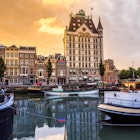

An annual calendar highlight in the Netherlands is King's Day (Koningsdag) with celebrations in April © Nisangha / Getty Images
In many ways, the Netherlands is a year-round destination, with each season offering its own charms. Spring sees fields full of tulips in bloom. Summer spells long days at sandy beaches along the coast and on the Wadden Sea islands, and as autumn turns to winter, the darkening chill invites you to embrace the Dutch quality of gezelligheid (conviviality, coziness) at atmospheric cafes. Cycling is a Dutch way of life, while festivals fill the calendar throughout the year.
When deciding which time of year to visit, you’ll also want to consider your budget, the crowds and The Netherlands’ notoriously fickle weather. Here’s everything you need to know to plan your perfect trip.

June to August is the best time for long days and warm weather
Summer is the Netherlands’ high season. Temperatures are at their peak (maximums average 19ºC (66ºF) in June and 21ºC (70ºF) in July and August), countryside cycles and canal cruises are at their most enjoyable, cafes spill out to lively terraces, and everything is open and in full swing, from small, out-of-the-way museums to secluded campgrounds and lively beach bars along the strands.
Urban streets turn into a gigantic party during festivities like the Netherlands’ biggest freely accessible event, Vierdaagsefeesten (summer festivals), when more than 40 stages and 1200 performances spread across its oldest city, Nijmegen, and the world’s only waterborne Pride parade floating through the capital during Pride Amsterdam. Unlike many sweltering European cities, Amsterdam doesn’t shut down for summer holidays, thanks to the temperate climate.
The flipside is that this is also the busiest, and priciest, time to visit, making planning ahead a necessity and limiting your options for spontaneity. Book everything – accommodation, museum time-slot entry, guided tours and in-demand restaurants – as far in advance as you possibly can. Look out too for quieter locales to use as a base: the Netherlands’ compact size and efficient transport considerably widens your options.

September and October are the best time for culture
The shoulder-season, post-summer months of September and October are some of the loveliest in the Netherlands. The weather can be glorious – temperatures are an average maximum of 18ºC (64ºF ) in September and 14ºC (57ºF) in October. When autumnal leaves start to fall, they uncover the architectural detail of gabled canal houses, making this time of year a favorite with photographers.
Fall marks the start of the cultural calendar, with ballet, opera, contemporary dance, classical concerts, jazz sessions and much more at venues throughout the country. Festivals are plentiful; blockbusters include Rotterdam’s Wereldhavendagen (World Port Days) and Amsterdam’s mammoth electronic music extravaganza ADE (Amsterdam Dance Event).
As crowds start to dissipate, sights become easier to book at shorter notice and accommodation prices begin drifting down. Daylight Saving Time ends on the last Sunday of October.

November to February are the best months for budget travelers
Once November arrives, so do low-season prices (with the exception of special events and holidays). Sights, along with some restaurants and hotels often reduce their hours, or even close completely for the season.
With temperatures an average maximum of 10ºC (50ºF) most months, and just 6ºC (43ºF) in January, it can rain more days than not, and sometimes snow, so make sure you have waterproofs and warm woolens. Ice-skating is a beloved national pastime when canals, lakes and rivers freeze in the chilliest years.
Dark days and long nights see the Netherlands’ candlelit bruin cafés (brown cafes; so called for their wood paneling and once-tobacco-stained walls) come into their own. Also lightening the mood are the dramatic illuminations of GLOW Eindhoven (in the design-driven home city of electronics company Philips) and the Amsterdam Light Festival (the best way to see its artistic installations is aboard a heated canal boat).
For children, the magic happens when Sinterklaas arrives in the capital by boat during Sinterklaas Intocht. A long-standing Dutch tradition sees Sinterklaas (Saint Nicholas) bring children presents and families exchange small gifts on December 5 ahead of religious celebrations for Christmas.
In the Catholic provinces in the Netherlands’ south, the days leading up to Shrove Tuesday (February or March) are the annual highlight, with Carnaval bringing exuberant celebrations to the streets. Maastricht’s celebrations are legendary.

March to May is the best times to see tulips
If the Netherlands’ national flower rates highly on your agenda, you’ll want to circle mid-March to mid-May to see them coloring the countryside like giant crayon streaks in the beautiful Bollenstreek (Bulb Region). Tulip fans can also catch the Bloemencorso (Flower Parade) which travels 26 miles (42km) through the region in mid-April (and even go behind the scenes to see how the flower-adorned floats are created during Decoration Days). Bear in mind that nature keeps its own schedule, so the blooms can flower later or finish earlier than usual depending on the year.
April also marks a major – and massively colorful – date on the Netherlands’ calendar. The Dutch national day, King’s Day (Koningsdag), on April 27 (April 26 if the 27th falls on a Sunday), celebrates the royal House of Orange, with orange-clad locals and visitors getting into the spirit all over the country. The biggest celebrations are in Amsterdam (don’t even think about showing up in the capital if you haven’t reserved accommodation!). Drawcards such as these mean that places to stay can be in short supply and come at a premium.
Spring can often be chilly, averaging a maximum of 10ºC (50ºF) in March, 13ºC in April (55ºF), and 17ºC (62ºF) in May, so bring warm layers to stay comfortable for long spells outdoors. Days rapidly lengthen, especially once Daylight Saving Time arrives on the last Sunday of March.
Explore related stories



 ActivitiesAmsterdam vs Berlin: which free-spirited European city should you visit first?
ActivitiesAmsterdam vs Berlin: which free-spirited European city should you visit first?Jun 24, 2024 • 7 min read

 Destination PracticalitiesHow to get around Amsterdam, one of Europe’s easiest cities to explore
Destination PracticalitiesHow to get around Amsterdam, one of Europe’s easiest cities to exploreJun 13, 2024 • 7 min read
 Art and Culture6 great day trips from Amsterdam for canals, windmills, cutting-edge buildings and more
Art and Culture6 great day trips from Amsterdam for canals, windmills, cutting-edge buildings and moreJun 11, 2024 • 6 min read
 Destination PracticalitiesWhat you need to know before you go to the Netherlands
Destination PracticalitiesWhat you need to know before you go to the NetherlandsMay 26, 2024 • 9 min read



